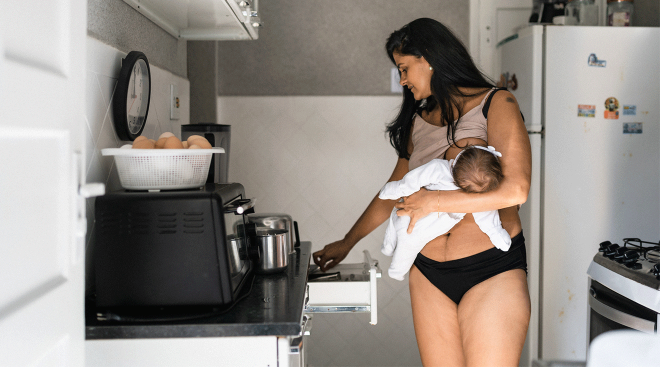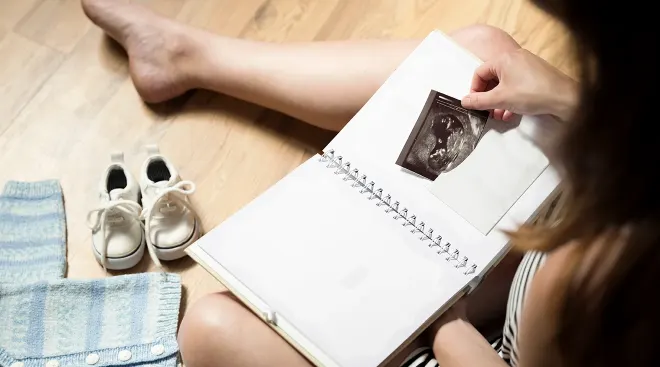- Some light spotting may occur at 37 weeks, and you might notice more vaginal discharge than usual. This is normal. However, if you lose your mucus plug or notice more than a little blood, call your doctor right away. It’s important to review the signs of labor (more below!).
- Baby probably weighs a healthy 6 pounds—give or take. But that doesn’t mean they’re fully cooked yet. They could benefit from another two or three weeks in utero—even though you’ve got that “stick-a-fork-in-me” feeling.
- Around week 37 of pregnancy, many moms-to-be find themselves organizing cupboards and scrubbing floors. That’s the phenomenon people lovingly refer to as “nesting.” It may be instinctual—your body senses baby will be here really soon. After all, you’re 37 weeks pregnant, which is considered “early term,” meaning baby is almost ready.
Baby is practicing some cool new skills: inhaling, exhaling, sucking and blinking. In less cute news, baby is getting the first sticky poop (called meconium) ready for their first diaper.
Your baby’s toenails began growing around week 17 and became visible around 20 weeks (even though they were mostly translucent!), but it’s only now that they’re fully formed. At 37 weeks, baby’s toenails actually cover their teensy little toes, reaching the end of each one. You won’t need to do much with them right after birth, however; infant toenails are soft and flexible, and grow pretty slowly.
If baby is facing head down, there’s a good chance their head has “engaged” with your pelvis by 37 weeks, especially if this is your first pregnancy. This means the widest part of Baby’s head has passed through the opening of your pelvis, making way for their future journey through the birth canal during labor and delivery. If this isn’t your first pregnancy, though, baby may not engage until labor actually starts.
How big is baby at 37 weeks?
At 37 weeks pregnant, baby is the size of a head of romaine lettuce. Baby measures about 19.1 inches. Average baby weight at 37 weeks is between 6 and 7 pounds, and baby is gaining about half an ounce or more each day.
Is my baby developed at 37 weeks?
While you’re so close to the finish line, baby is still doing some important work in your belly. Their circulatory and musculoskeletal systems are done developing, but their lungs, brain and nervous system are still getting some last-minute touch-ups. A week or two can make a big difference!
37 weeks pregnant is how many months?
When you’re 37 weeks pregnant, you’re nine months pregnant. You’ve got just three weeks until your due date.
37 week ultrasound
A 37-week ultrasound might be performed as part of a biophysical profile. The profile is designed to gauge baby’s well-being, using ultrasound and the results of a non-stress test.
For moms who are 37 weeks pregnant with twins, your doctor might talk to you about induction or c-section (depending on your medical history and babies’ statuses). Some doctors recommend this happen at 38 weeks pregnant with twins, so you could be meeting your babies in just a week!
No matter how or when you’re going to deliver your baby (or babies!), try not to get too impatient waiting. Remind yourself that it could be any day now—or it could be a few weeks. If you’re feeling antsy, go find something else to clean. (Think you’ve got everything? Look behind the fridge.)
At 37 weeks pregnant, symptoms can be confused with signs of labor. Here’s what you might be feeling this week:
Heartburn
Baby continues to put pressure on your digestive system as you near your due date. Avoid spicy foods and drink plenty of water to prevent heartburn.
Spotting
A little bit of spotting is normal at week 37 of pregnancy—remember, your cervix is extra sensitive while you’re pregnant, so sex can irritate it and make it bleed. But call your doctor if it’s more than just a few drops of blood. Vaginal bleeding could be a sign of a problem with the placenta (such as placental abruption) and it’s important to seek treatment right away. Also, don’t confuse spotting or bleeding with the “bloody show,” a discharge tinged with blood that’s a totally harmless sign your cervix is changing to prep for delivery.
Stretch marks
Sorry, but new stretchies might appear on your 37 weeks pregnant belly and each week from here on out. Keep that body oil on hand and slather it on when you can. Also, keep drinking lots of water, even though you’re heading to the bathroom, oh, every two minutes.
Abdominal pressure
If baby has dropped down into your pelvis in anticipation of labor, they’re putting increased pressure on your abdomen, which might make you feel some new aches and pains down below—and a greater urge to pee too!
Trouble sleeping
It’s normal to be up in the middle of the night in late pregnancy. Some strategies for getting more ZZZs: Get plenty of light exercise during the day, drink lots of water—except right before bedtime—and limit your caffeine intake.
Contractions
At 37 weeks, cramping or contractions are to be expected. After all, you’re going to have a baby soon—your body is ramping up! You may find that your contractions go away if you sit or lie down. That means they’re Braxton Hicks, not real labor contractions.
Nausea
An upset stomach is pretty typical almost any time during pregnancy. But now that you’re so close to your due date, it could be a sign you’ll go into labor soon. (Whoa!) If your nausea is severe—if you’re vomiting, especially—tell your OB so they can rule out illness or a pregnancy complication such as HELLP or preeclampsia.
Are you 37 weeks pregnant with twins? About 60 percent of twins are born before pregnancy week 37, so if your twosome is still hanging in there, you’re in the minority among moms of multiples. And while you’re probably feeling super uncomfortable and really antsy to get those babies out, you’re doing a really good thing for their health by sticking it out.
What if I can barely walk at 37 weeks pregnant?
We get it—with the pressure on your belly and pelvis, the swollen feet and the overall fatigue, the farthest you want to walk may be the trip to your couch so you can lie down. But unless your doctor advises against it, take a stroll around the block. Exercise helps with so many things in the third trimester—including sleep, body aches and swelling—and walking is one of the best forms of physical activity because it’s gentle on your body.
When you’re 37 weeks pregnant, it’s the perfect time to brush up on the signs of labor. Each day, your likelihood of going into labor goes up, and who wants to be stuck in a car giving birth because they waited too long to get to the hospital? (We don’t mean to scare you—the chances you’ll give birth in a car are low. We just want you to be prepared.)
The various signs of labor tend to fall into two categories—those that mean it’s coming soon and those that mean it’s happening now.
You’ll go into labor soon if you notice these signs of labor at 37 weeks (though we can’t say how soon—every pregnancy is different. Sorry!):
Mucus plug and/or bloody show
You may see a bit of thick mucus come out onto your underwear, either in one big glob or little by little. This is the mucus plug, which has been protecting your cervix all along. As your cervix dilates, the mucus plug is released to make way for baby. The mucus plug may or may not have a tinge of blood in it—if it does, that’s the “bloody show.”
Nausea
Some women swear they start to feel sick to their stomach just before labor begins. So at 37 weeks pregnant, nausea might mean baby is coming soon.
Diarrhea
When you’re 37 weeks pregnant, diarrhea could just be diarrhea or it could mean impending labor. That’s because as your hormones change to prep for delivery, they can also stimulate your bowels.
Below are the signs labor is here. It’s time to call your OB right away:
Water breaking
If you feel water leaking out, either in a gush or a trickle, that’s probably amniotic fluid. Most women go into labor within 24 hours of their water breaking.
Regular contractions
Has your 37 weeks pregnant belly been tightening on the reg? If the contractions keep repeating and they seem to be coming more and more frequently, you’re in labor. As your uterus contracts, it’s dilating your cervix so baby can pass through at delivery. If this is your first pregnancy, you may have regular contractions for several hours before you go into what’s known as “active labor”—that’s when contractions get really painful and will require all your attention. (And that’s when you should be at the hospital!)
Back pain
Ah, the dreaded “back labor.” Sometimes baby is positioned in a way that puts extra pressure on Mom’s spine. If you get constant back pain that’s more severe than any you’ve had so far in pregnancy, or the pain radiates from your abdomen to your back (or vice versa), it could mean you’re in labor.
Your doctor will tell you at what point to get your 37 weeks pregnant belly to the hospital. If your water has broken, your doctor could advise that you be admitted right away, because you may need to be monitored for infection. If you’re having contractions but your water hasn’t broken, they’ll probably need to happen consistently five minutes or less apart before many hospitals will admit you—so the farther away you are, the sooner you’ll need to leave your home.
Is it safe to deliver at 37 weeks?
Another week or two in your belly will lower the risks of potential health problems for baby. You’re probably impatient to finally see and hold baby in your arms, but don’t be tempted to schedule an early induction (unless your doctor is advising it) or attempt to induce labor on your own with a home remedy. If you go into labor naturally, that’s totally cool, but there’s no need to rush things. We promise it will be worth the wait!
You've probably heard of the epidural, but there are lots of other methods, both medical and non-medical for pain relief. Nitrous oxide, or laughing gas, is a medical option that is self-administered during a contraction to help ease the anxiety and pain associated with labor. A benefit of nitrous oxide is that you can continue to move around and be active while in labor. Some non-medical options include massage and heat, water immersion either in a shower or tub and aromatherapy with essential oils.
Here’s what you can do this week as you approach the finish line. You’ll be meeting baby in no time!
Quench your thirst
Make sure you drink plenty of water, because dehydration can make your uterus contract, causing discomfort. And remember, it also helps with other 37 weeks pregnant symptoms like heartburn.
Get some ginger
Feeling queasy? A bit of ginger might snap you out of it. Make your own tea with fresh ginger and boiling water, sip on ginger ale or nibble on crystallized ginger, either on its own or sprinkled on top of yogurt and berries. If the nausea is really bad, ask your doctor to recommend a ginger supplement. Splurging on a ginger cookie may work too!
Slather on the hyaluronic acid
This pregnancy-safe, moisturizing powerhouse may help improve the appearance of stretch marks, so find a cream or oil that includes it in the ingredient list. (And the higher up it is on that list, the more hyaluronic acid there is in the product.) You’ve got to apply it every day to see potential results and take the time to massage it into your belly—which will feel sooooo good if you’ve got dry, itchy skin or abdominal pressure!
Put your partner to work
If you’re in nesting mode, you want to get everything done, but you can’t tackle it on your own. Create a to-do list with your partner and divvy up the tasks. You’ll be ready for baby in no time!
Frequently Asked Questions
What is HELLP syndrome, and how is it related to pregnancy complications?
HELLP is an acronym for a pregnancy complication involving hemolysis (breakdown of red blood cells), elevated liver enzymes and low platelet count. It’s a serious condition that may be a variation of preeclampsia, or severe hypertension in pregnancy; some women are diagnosed with preeclampsia before they develop HELLP, while others experience HELLP symptoms first.
Either way, HELLP can be dangerous: in most cases, baby will be delivered right away, even if you’re not full-term. This is because HELLP syndrome can cause serious and life-threatening complications for Mom and baby, including liver rupture, stroke, hemorrhage, placental abruption and clotting problems.
What are common methods of pregnancy induction, and when are they typically considered?
There are basically two ways to induce labor: with medications or through the use of mechanical methods. Medications such as prostaglandins and oxytocin can be given to either ripen the cervix and/or stimulate uterine contractions, while inflatable balloon catheters and stripping (or sweeping) the amniotic membrane are mechanical ways of opening the cervix, initiating contractions and potentially kickstarting labor.
Is diarrhea a sign that labor is coming?
It can be. Some women experience diarrhea as their body prepares for labor, but this can happen several weeks before you actually go into labor (or, yes, just a few hours!). You shouldn’t assume that having diarrhea in the third trimester means you’re going into labor soon, but if the diarrhea occurs alongside other symptoms of labor—like increased contractions and loss of mucus plug—then it could be a sign that labor is about to start for real.
When does maternity leave start?
Some women work all the way up until they deliver and then start their maternity leave. Others start their leave one or two weeks before baby is due, especially if they’re having difficulty working through the end of pregnancy. It’s highly dependent on your health and pregnancy, as well as your employer, your employee benefits and the laws in your state.
If your employer offers maternity leave, the parameters for when it can start should be outlined in your employee handbook. If your employer doesn’t offer maternity leave, you may still be able to take time off under the Family and Medical Leave Act (FMLA) or utilize short-term disability. That said, there are restrictions for FMLA, in particular, so you should make sure you’re aware of all your options before planning your leave.
Should I be worried if baby is still breech?
Possibly, but not necessarily. Babies can turn at the last minute, so there’s still time for them to get into position. Still, it’s a good idea to start making a plan with your healthcare provider for what will happen if baby doesn’t turn around in time.
A planned C-section might be necessary to safely deliver a breech baby. However, many providers will make at least one attempt to reposition Baby inside the womb; a procedure called external cephalic version may be performed to try and get baby to move head down.
I remember Googling 'Is it too early to be nesting?.' Organizing closets and drawers, researching baby products, and designing the nursery gave me a much-needed distraction (and sense of control) throughout my pregnancy.
Please note: The Bump and the materials and information it contains are not intended to, and do not constitute, medical or other health advice or diagnosis and should not be used as such. You should always consult with a qualified physician or health professional about your specific circumstances.
Samir E. Hage, DO, is an ob-gyn at Redlands Community Hospital in California. He earned his medical degree from the Western University of Health Sciences in Pomona, California.
Cleveland Clinic, Bloody Show, July 2021
Mayo Clinic, Signs of Labor: Know What to Expect, December 2021
American Pregnancy Association, Mucus Plug – What Is It & What Does It Look Like?
Cedars Sinai, Small for Gestational Age
March of Dimes, Why At Least 39 Weeks Is Best for Your Baby, October 2018
American Pregnancy Association, Nesting During Pregnancy
March of Dimes, What Is Full-term?, September 2018
National Institutes of Health, Analysis of Fetal Breathing Movements at 30-38 Weeks of Gestation, October 2005
National Institutes of Health, Prenatal Thumb Sucking Is Related to Postnatal Handedness, September 2004
National Institutes of Health, Fetal Grasping of the Umbilical Cord and Perinatal Outcome, October 2003
Cleveland Clinic, Fetal Development, March 2023
National Institutes of Health, Meconium Analysis to Detect Fetal Exposure to Neurotoxicants, August 2006
American Pregnancy Association, 37 Weeks Pregnant
Mayo Clinic, Fetal Development: The 3rd Trimester, June 2022
Kaiser Permanente, Your Developing Baby – Week 37, July 2022
American Lung Association, An Amazing Journey: How Young Lungs Develop, May 2018
National Institutes of Health, Developmental Scores at 1 Year With Increasing Gestational Age, 37–41 Weeks, May 2013
Mount Sinai Hospitals, Fetal Development, July 2021
Lamaze International, How Far Along Are You? Counting Pregnancy by Weeks, Months & Trimesters, September 2021
Cleveland Clinic, Due Date Calculator, October 2021
Cleveland Clinic, Biophysical Profile, December 2022
National Institutes of Health, Elective Birth at 37 Weeks' Gestation for Women with an Uncomplicated Twin Pregnancy, February 2014
National Institutes of Health, Induction of Labor in Twins—Double Trouble?, March 2023
Stanford Medicine Children's Health, Pregnancy and Heartburn
Mayo Clinic, Incompetent Cervix, April 2023
Mayo Clinic, Placental Abruption, February 2022
Mayo Clinic, Stretch Marks, January 2023
Cleveland Clinic, Stretch Marks, May 2022
American Pregnancy Association, Diarrhea in Pregnancy
Kaiser Permanente, Pregnancy: Dropping (Lightening), July 2023
Sleep Foundation, Pregnancy Insomnia, June 2023
March of Dimes, Contractions and Signs of Labor, December 2018
Henry Ford Health, What No One Tells You About Labor And Delivery, July 2020
Johns Hopkins Medicine, Why Is Multiple Pregnancy a Concern?
The American College of Obstetricians and Gynecologists, Exercise During Pregnancy, March 2022
Cleveland Clinic, Mucus Plug, July 2021
Cleveland Clinic, Preterm Labor, November 2022
Cleveland Clinic, Pregnancy Constipation: Why It Happens and How To Find Relief, December 2021
Mayo Clinic, Water Breaking: Understand This Sign of Labor, November 2021
Cleveland Clinic, Water Breaking, October 2022
March of Dimes, Contractions and Signs of Labor, December 2018
Mayo Clinic, Stages of Labor and Birth: Baby, It's Time!, January 2022
March of Dimes, Stages of Labor, March 2019
Cleveland Clinic, Back Labor, September 2021
Cleveland Clinic, Water Breaking, October 2022
National Institutes of Health, Time of Delivery Among Low‐risk Women At 37–42 Weeks of Gestation and Risks of Stillbirth and Infant Mortality, and Long‐term Neurological Morbidity, March 2022
Mayo Clinic, Inducing Labor: When to Wait, When to Induce, May 2022
National Institutes of Health, Hydration for Treatment of Preterm Labour, November 2013
Minnesota Department of Health, Heartburn & Upset Stomach During Pregnancy
American Association of Family Physicians, Ginger for the Treatment of Nausea and Vomiting in Pregnancy, November 2011
American Academy of Dermatology, Stretch Marks: Why They Appear and How to Get Rid of Them
Mayo Clinic, Partners in Pregnancy: Preparing for a Baby Together
Learn how we ensure the accuracy of our content through our editorial and medical review process.
Navigate forward to interact with the calendar and select a date. Press the question mark key to get the keyboard shortcuts for changing dates.















































